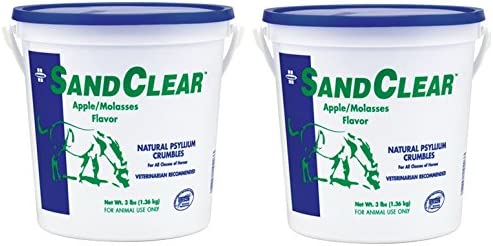If you are an equestrian living in the UAE I’m pretty sure you have heard about horses sand colics before. A sand colic is often the consequence of the continuous ingestion of small amounts of sand that can cause abdominal pain in the horse. The sand gets accumulated in the intestines and causes irritation and possibly results in a colic due to a partial or complete obstruction. Horses that are fed or kept for a long time on sandy soil are more at risk than horses that can benefit from a straw bedding. All horses can experience a sand colic, even though some horses are more prone to it than others. One of the most effective ways of keeping a low risk of sand colics is by making routine use of psyllium fiber.
How to recognize a sand colic
Sand colic symptoms do not differ from gas colics or obstruction problems. Although based on the initial symptoms you most probably won’t be able to classify a potential colic as a sand colic.
The typical signs of colic in horses which most equestrians are familiar with are:
– Sweating, increased breathing rate
– Rolling, lying down and getting up repeatedly, violently throwing themself on the ground
– Looking, kicking or biting at the flank
– Pawing the ground, tail swishing
– Extreme dullness or agitation
– Inappetence
– Curling upper lip or bloodshot eyes.
In the long term, sand ingestion can lead to weight loss or chronic diarrhea. If you suspect any of these symptoms in your horse it is always advisable to get in touch with a veterinarian as soon as possible to avoid possible complications. Studies that are usually required to evaluate the presence and amount of sand in a horse’s intestine includes ultrasounds, radiographs (X.ray) and an evaluation of the intestine’s position and mobility.
How to prevent a sand colic with Psyllium fiber
When it comes to sand colics, prevention is the best cure. Psyllium is a vegetable fiber derived from the ripe seeds of an herb called Plantago, mostly grown in India. Plantago produces gel-coated seeds from which husks are extracted Psyllium fiber. Adding Psyllium fiber to a horse diet is known as the most efficient way to prevent sand colics. Once psyllium enters the digestive tract, it can increase in volume as much as five times, helping move accumulated sand out with the stool. Used as a supplemental source, a psyllium-based product is typically given daily for one week out of every month.
One of the best products that you can find in the UAE is most probably SandClear by Farnam.
I personally purchased this product directly on Amazon and you can find it at the link below.

How to feed SandClear to your horse
I used SandClear for my horse in the past 6 months. The package included 2 buckets of 3lb each that lasts me for 3 cycles of 1 week each, once per month. While my horse never experienced sand colics before he is spending most of the time on sandy soil. I just want to make sure he gets all the support he needs to maintain a healthy gut and digestive tract.
Being a small Arabian horse, I just add around 4 oz to his feed (just a bit less than the recommended dose of 5 oz). I usually mix all the feed and let it soak in the bucket for around 20 minutes before feeding.

Other ways of preventing sand colics
In addition to Psyllium fiber cycles, there are a series of actions that you may want to take to prevent sand colics.
1. Don’t place hay or feed directly on the ground.
Even if you feed your horse with a bucket or leave the hay net hanging on the side of his box, at a certain point he will reach the ground to look for the dropped feed. If he doesn’t have a bedding made of straw he will most probably ingest sand just by grazing around. To avoid him picking up dirt and sand with his feed you can use a rubber mat to cover a small surface, enough for him to step over it to eat.
I personally use this exercise floor mat that I positioned over a small concrete pad in his box.
It may take some effort to reassemble it when the horse dances on it but at least it is an easy to clean, low budget option that you can replace at any time.
2. Feed ample forage.
A steady supply of hay will induce the movement of sand within the intestine before it can get settled.
3. Encourage your horse to drink a lot of water.
Along with good forage, water can help the intestinal contents move. If you notice your horse is not getting to the water bucket as often as he should, you can always add a salt lick near his hay. This Himalayan pink salt block is 100% natural and contains 84 valuable minerals. Not only will you help your horse drink more but also get all the minerals he needs!

4. Turn out your horse whenever you can
Being in the UAE is not always easy to find a grass field to let your horse graze from. But if your stable has a green area, make sure to bring your horse there very often or ask your groomer to do it for you.
As much as we artificially try to reproduce the natural living conditions of the horse with 24h hay, nothing can replace a good pasture!
I hope this article helped you. If you have comments or suggestions, please leave a comment below and I will be happy to make amends to this content.


